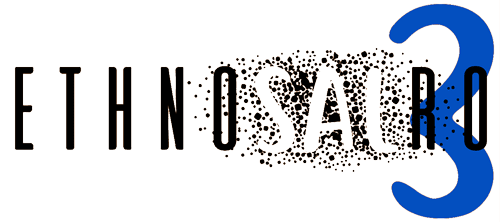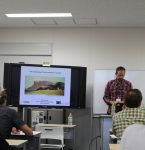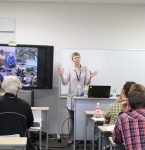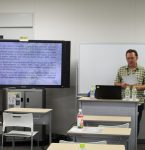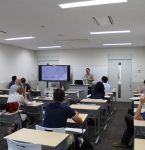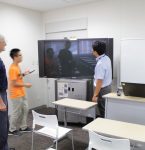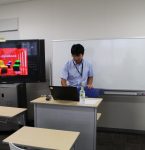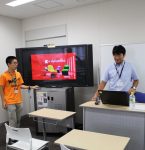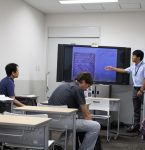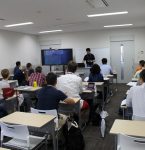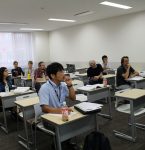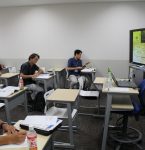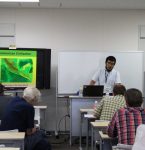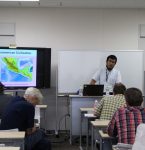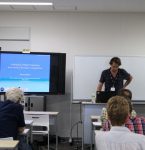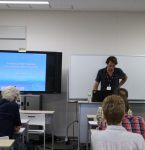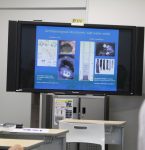Photos: Măriuc Vornicu, Felix-Adrian Tencariu
WAC 8 session ‘Archaeology of Salt between Local and Global’ paper list:
1 ===========
Your name: Qiaowei Wei
Affiliation: Shanghai University
Country: China
Type: Paper presentation
Title: Made locally or Long-distance transportation? New evidence on ceramic vessels from Salt production sites of Late Shang period in North Shandong
Abstract: Questions about the salt production in Ancient China have been examining the function, typology, and chronology of a certain type of ceramic vessel, the Kuixingqi (Helmet-shaped vessel). Instead of examining typology of Kuixingqi vessels from salt workshops at North Shandong region, dated to 3000 BC, I will begin by looking at how those Kuixingqi vessels made and transported into the salt workshops, if those vessels are not made locally. I present the findings of the ceramic petrographic analysis conducted on Kuixingqi vessels, of which I present the ceramic material components by the low res microscope. This analysis will give us better understanding of how ceramic vessels made for salt workshops, and what is the baseline for salt workshop manage the production process.
Keywords: petrographic analysis; material components; salt pottery management
2 ===========
Your name: Wes Forsythe
Affiliation: Ulster University
Country: United Kingdom
Type: Paper presentation
Title: The Archaeology of Salt Production in Ireland
Abstract: No systematic examination of salt production in Ireland has been carried out until very recently. A two year project undertaken by Ulster University has begun the process of collecting archaeological evidence for indigenous production as well as sources of importation. For a country that has long relied on agricultural exports, salt was crucial for curing hides, preserving meats and fish and dairy products. Prehistoric evidence remains sparse and as such the first phase of the project began with the post-medieval era. Located too far north to take advantage of solar evaporation, Ireland had to force salt from sea water and later rock salt. It also had to overcome problems associated with fuel poverty. The archaeological remains include upstanding structures of salt pans, stores, accommodation, and infrastructure in rural and urban contexts; as well as evidence from excavation.
Keywords: Post-medieval, Ireland, industrial
3 ===========
Registration number: 0297
Your name: Akira Ichikawa
Affiliation: Nagoya University
Country: Japan
Second author
Name: Hiroaki Yagi
Affiliation: Ehime University
Country: Japan
Type: Paper presentation
Title: Ancient Pottery Salt Production in the Pacific Coast of Southeastern Mesoamerica
Abstract: Although there are several types of salt sources and salt-making techniques in various regions of Mesoamerica, access to salt has always been limited. It is widely known that salt making and trade played a fundamental role in the Mesoamerican economy and culture since ancient times. However, ancient salt-making techniques are not well known archeologically. This study presents novel comprehensive archeological data of pottery salt production during the Terminal Preclassic and Early Classic period (AD100–400) in the Pacific Coast of southeastern Mesoamerica, thereby contributing toward comparative studies of salt in other parts of the world.
Keywords: salt production, pottery, El Salvador, Mesoamerica
4 ===========
Registration number: 0263
Your name: Takamune Kawashima
Affiliation: Yamaguchi University
Country: Japan
Type: Paper presentation
Title: Archaeology of salt in Japan – an international comparative study
Abstract: The field of archaeology of salt in Japan has been developing in association with other fields, such as history, folklore, ethnology and analytical chemistry. As the oldest discovered evidence of Japan’s salt production was pottery for boiling brine and making salt cakes, archaeologists have mainly focused on the pottery and the facilities such as hearths found at production sites. However, rich evidence of salt production in Japan has prevented comparative studies of salt production abroad. In this paper, describing the latest issues on salt in Japanese archaeology, I explore the possibility of a comparative study developed with research institutions overseas.
Keywords: salt production, Japan, interdisciplinary
5 ===========
Registration number: 0634
Your name: Felix Adrian Tencariu
Affiliation: ‘Alexandru Ioan Cuza’ University of Iasi
Country: Romania
Second author
Name: Marius Alexianu
Affiliation: ‘Alexandru Ioan Cuza’ University of Iasi
Country: Romania
Third author
Name: Andrei Asandulesei
Affiliation: ‘Alexandru Ioan Cuza’ University of Iasi
Country: Romania
Type: Paper presentation
Title: ‘Rock Salt around the Clock’.
Ethnoarchaeological Research in Romania Concerning Salt Extraction by Shepherds
Abstract: In Romania, an EU Member State since 2007, there are several mountainous areas with enduring ancient practices of animal husbandry and exploitation of salt resources. Here, shepherds quarry rock salt outcrops two to three times per year as nutrients for their sheep flocks, which travel up to 20-30 km. Salt thus becomes an essential element for increasing the spatial parameters of pastoral mobility. Complex ethnological models emerged within a broader research project (cf. ethnosalro.uaic.ro), opening new windows to understanding the pre-mining phase of rock salt exploitation of world-renowned archaeological sites such as Hallstatt.
Keywords: Ethnoarchaeology, salt, pastoral mobility.
6 ===========
Registration number: 0675
Your name: Flora Vilches
Affiliation: Universidad de Chile
Country: Chile
Type: Paper presentation
Title: Rock salt mining in San Pedro de Atacama, northern Chile, during the 20th century: between artisan and industrialized exploitation
Abstract: Salt exploitation in Atacama is one among many expressions of capitalist expansion in Latin America during the 20th century. Historical documentation of these practices is scarce, although material remains and former actors in the mining process still survive. In this article we present archaeological evidence of salt mining sites of different temporality, scale and kind of exploitation. Such differences show how capitalism in the area has not been a homogenous process. We discuss the social implications of the coexistence of artisan salt exploitation and industrialization for the native indigenous population within the context of a locality both isolated and globalized.
Keywords: capitalism, mining, salt
7 ===========
Registration number: 0822
Your name: Mihaela Asăndulesei
Affiliation: ”Alexandru Ioan Cuza” University of Iași
Country: Romania
Type: Paper presentation
Title: Perceiving the past, assessing the present, mitigating the future. Archaeological evidences and intangible heritage of salt in Eastern Romania
Abstract: This paper aims to highlight the abundance of saline occurrences in Eastern Romania and the human behaviour in relation with this natural resource, in a diachronic plan. The salt springs, a natural constant, have left a strong mark on everyday life, since Neolithic times, but have also generated a very developed intangible heritage. The continuity of the traditional practices of exploitation of natural brine in this rural milieu, still at a high level of intensity, warrants a special attention to this salt universe, threatened by globalization and impending civilization.
Keywords: salt springs, heritage of salt, Eastern
Romania
8 ========
Registration number: 0894
Your name: David Bloch
Affiliation: Bloch Salt Archive
Country: Israel
Type: Paper presentation
Title: Global salt source monopolies: the primary social influence upon civilizations for many centuries as a direct cause and effect linked to fluctuating eustatic sea levels Abstract: The science of Global warming has only very recently shown that changing ocean and sea levels are a fact. Since the last ice age more than 15 millennium ago when sea levels rose more than 100m, only minor fluctuations have occurred ±2 meters. However, so minor were these changes that historians and archeologists have neglected to differentiate between ocean tides and net eustatic changes. Yet eustatic sea levels have profoundly affected the production of salt in coastal evaporation pans at certain periods and were an important global connection between historical narratives. “Commonsalt” osmosis, possibly ancient man’s oldest technology was most used for preservation [eg mummification] to dehydrate perishable items. Now it is replaced by the “fridge” and cooling units, invented only as recently as 100 years ago.
Keywords: salt, monopoly, sea-levels
9 =======
Registration number: 0249
Your name: Olivier Weller
Affiliation: CNRS
Country: France
Type: Paper presentation
Title: Prehistory of Salt Production: from local to European perspective
Abstract: This paper deals with the origin and development of salt production in Europe. Starting from the current research on the Neolithic exploitation to the Iron Age industry, we examine the history of exploited natural salt resources, the diversity of archaeological evidence, and forms of salt working. The types of production for these early forms of salt exploitation, with or without the use of crudely-fired clay vessels (briquetage), are directly connected to the socio-economic context. Finally, we highlight both the diversity of salt products, as well as their uses, which go well beyond dietary roles.
Keywords: Europe, Neolithic, Briquetage
10 =======
Registration number: CC BY 2016 t-mizo
Your name: Kerstin Kowarik
Affiliation: Natural History Museum Vienna
Country: Austria
Second author
Name: Hans Reschreiter
Affiliation: Natural History Museum Vienna
Country: Austria
Type: Paper presentation
Title: The prehistoric salt mines of Hallstatt: provisionning processes and economic structures
Abstract: Mining structures of the size and kind of the Hallstatt salt mines do not only represent important centres of production but also centres of consumption and generate high demands of workforce, means of production and subsistence. Production units tied to a certain place, such as mining facilities, are especially dependant on reliable provisioning lines. Regular shortages can lead to the abandonment of even exceptionally rich deposits. Difficult access and/or remoteness impede provisioning. Therefore recent research has focused on characterizing the demand of the salt mines in terms of tools, food and workforce as well as the connection to its surroundings.
Keywords: salt, mining, resource management
11 =======
Registration number: 4396
Your name: Marius Alexianu
Affiliation: “Alexandru Ioan Cuza” University of Iasi
Country: Romania
Type: Paper presentation
Title: Ethnoarchaeology of salt attractors in Romania. A diachronic model
Abstract: Ethnological investigations carried out in Romania (cf. ethnosalro.uaic.ro) on the influences of the salt springs and outcrops on human communities allowed the creation of an ethnological radial model of salt distribution. Its application to various archaeological sequences show that these salt attractors determined human settling within a range of max. 5 km, beyond which other parameters took hold. Inhabitants of settlements located up to 30 km had a twofold function: collecting salt for their own needs, and furnishing with salt settlements found up to 100 km away. The validity of this regional model must be tested on the global level.
Keywords: ethnoarchaeology, salt, salt spring, salt attractor, Romania, diachronic model, human occupation
Poster 1===========
Registration number: 0263
Your name: Takamune Kawashima
Affiliation: Yamaguchi University
Country: Japan
Second author
Name: Kei Aoshima
Affiliation: Yamaguchi City Board of Education
Country: Japan
Third author
Name: Viorica Vasilache
Affiliation: ‘Alexandru Ioan Cuza’ University of Iasi
Country: Romania
Other authors: Ion Sandu/’Alexandru Ioan Cuza’ University of Iasi/Romania, Felix-Adrian Tencariu/’Alexandru Ioan Cuza’ University of Iasi/Romania
Type: Poster presentation
Title: Archeometric Analyses on Salt Pottery from Minogahama Site, Japan
Abstract: The Minogahama site is well-known for the salt production through evaporation of sea water of the Late Kofun period and the beginning of ancient period, ca. 6-7th century AD. Several ceramic samples of pottery presumed to be related with this process were analyzed by means of optical microscopy (OM) and scanning electron microscopy (SEM-EDX). Subsequently, analyses were undertaken on two samples of clay from the site area, three samples of sea grass and salt obtained from the sea water. Corroborating the results brings some new clues about an ancient chaine opératoire and behaviors known previously rather hypothetically.
Keywords: archeometric analyses, salt pottery, Japan
Poster 2===================
Registration number: 3000
Your name: Hiroki Takanashi
Affiliation: Tobacco & Salt Museum
Country: Japan
Type: Poster presentation
Title: An introduction of the museum that has potential to act as a mediator between the salt-related studies and societies
Abstract: Is it possible that a museum links salt archaeology, anthropology, other fields and visitors? The Tobacco & Salt Museum founded in 1978, was relocated and re-opened nearby Tokyo Sky Tree on 2015. The new salt exhibition focuses on the story that salt have deep, ancient connections with human history and cultures, taking major but unconscious roles in life-supporting throughout the world. From ancient times such as pre-human, through the history of trying to find various salt resources and ways of making salt, people found out its usefulness for foods and other industries. All of them are connected into one museum.
Keywords: salt anthropology, mediator, museum
===========
Observer
- S.K. PACHAURI, IAS (RETD) Flat No. T4 / 202 Parsvnath Prestige – II Sector – 93 A Taj Express High Way NOIDA – 201 304 CELL NO;09810946722 Land line:120-2426600
